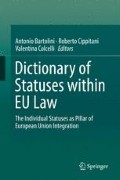Abstract
The phrase ‘Human Resources in Science and Technology’ (HRST) has been coined in the ‘Canberra Manual’ (OECD, ‘The measurement of scientific and technological activities. Manual on the measurement of human resources devoted to S&T: “Canberra Manual”’, Paris, 1995) of the Organisation for Economic Cooperation and Development (OECD) in order to identify and to measure for statistical purposes the special skilled labour force required by the rapid change and new challenges that are emerging in science and technology.
According to the Manual, HRST may refer to ‘human resources actually or potentially devoted to the systematic generation, advancement, diffusion and application of scientific and technological knowledge’.
Researchers and, in general, HRST represent an important share of employees within Europe and in the last 20 years, the phenomenon of the mobility of researchers and other HRST has dramatically increased because of the EU integration process and specific actions put in place by the EU, such as the Framework Programmes and, in particular, the Marie Skłodowska Curie actions, which are specifically focused on the mobility of researchers.
EU sources recognise that researchers and HRST have a particular position, introducing a specific understanding of the EU freedoms. As matter of fact, EU legal sources identified ‘freedom of knowledge’ as the ‘fifth freedom’.
In addition to freedom of circulation, EU law identifies several rights concerning HRST, as well as a set of obligations.
Access this chapter
Tax calculation will be finalised at checkout
Purchases are for personal use only
Notes
- 1.
OECD, ‘The measurement of scientific and technological activities. Manual on the measurement of human resources devoted to S&T: “Canberra Manual”’, Paris, 1995.
- 2.
OECD, ‘Guidelines for Collecting and Reporting Data on Research and Experimental Development: Frascati Manual’, 2015, para. 5.35.
- 3.
European Commission, ‘Researchers in the ERA: One profession, multiple careers’, COM (2003) 436 of 18 July 2003, para. 2.
- 4.
See: Glossary: Human resources in science and technology (HRST), available at: http://ec.europa.eu/eurostat/statistics-explained/index.php/Thematic_glossaries.
- 5.
European Commission, Communication to the Spring European Council, ‘Working together for growth and jobs – A new start for the Lisbon Strategy’, COM(2005) 24 final, 2 February 2005, para. 3.3.
- 6.
European Commission, ‘Building the ERA of knowledge for growth’, COM(2005) 118 final, 6 April 2005.
- 7.
European Commission, Communication, ‘Better careers and more mobility: A European partnership for researchers’, COM(2008) 317 final.
- 8.
European Commission, Communication to the Spring European Council, ‘Working together for growth and jobs’, n. 5.
- 9.
Moreover see the following judgments: ECJ 13 Feb. 1985, Case 293/83, Gravier v Ville de Liège, [1985] ECR p. 593; ECJ 2 Feb. 1988, Case 24/86, Blaizot v Université de Liège and others, [1988] ECR p. 379.
- 10.
ECJ 3 Jul. 1986, Case 66/85, Lawrie-Blum, [1986] ECR p. 2121, para. 19; ECJ 26 Feb. 1992, Case C-3/90, Bernini, [1992] ECR p. I-1071; ECJ 17 Mar. 2005, Case C-109/04, Kranemann, [2005] ECR p. I-2421, paras. 15 and 16.
- 11.
ECJ 25 Jul. 1991, Case C-58/90, Commission v Italy, [1991] ECR p. I-4193.
- 12.
Decision of the Council of 15 June 1987, for the period 1990–1994.
- 13.
European Commission, ‘Communication, Better careers and more mobility’, n. 7; European Commission, ‘Reviewing Community innovation policy in a changing world’, COM(2009) 442 final, 2 September 2009.
- 14.
e.g.: ECJ 17 Jul. 2008, Case C-94/07, Raccanelli, [2008] ECR p. I-5939, relating to the social scheme applicable to PhD students; ECJ, 30 Nov. 2000, Case C-195/98, Österreichischer Gewerkschaftsbund, [2000] ECR p. I-10497; ECJ, 26 Jun. 2001, Case C-212/99, Commission v Italy, [2001] ECR p. I-4923; ECJ, 2 Aug. 1993, Cases C-259/91, C-331/91 and C-332/91, Pilar Allué and Carmel Mary Coonan and others v Universita degli Studi di Venezia and Universita degli Studi di Parma, [1993] ECR p. I-04309.
- 15.
e.g.: ECJ 2 Jul. 1996, Case C-473/93, Commission v Luxemburg, [1996] ECR p. I-03207; ECJ 2 Jul. 1996, Case C-290/94, Commission v Greece, [1996] ECR p. I-3285). For instance, those interests cannot be invoked to reserve a job in a public research body for citizens of a particular Member State (see ECJ 16 Jun. 1987, Case 225/85, Commission v Italy, [1987] ECR p. 2625).
- 16.
European Commission, Communication of the Commission to the Spring European Council, ‘Working together for growth and jobs’, n. 5.
- 17.
The two documents are annexes to the Recommendation 2005/251/CE of 11 March 2005. See https://euraxess.ec.europa.eu/jobs/charter/european-charter.
- 18.
Code of Conduct for the Recruitment of Researchers enclosed to Recommendation 2005/251/CE of 11 March 2005.
References
Álvarez Ledesma, M. I., & Cippitani, R. (Eds.). (2013). Diccionario analítico de Derechos humanos e integración jurídica. Rome: ISEG.
Balibar, E. (2001). Nous, citoyens d’Europe? Les frontières, l’état, le people. Paris: la Découverte.
Balibar, E., & Wallerstein, I. (2007). Race nation classe. Les identités ambigües. Paris: la Découverte.
Cippitani, R., & Gatt, S. (2009). Legal developments and problems of the Bologna process within the European higher education area and European integration. Higher Education in Europe, 34, 385–397.
Crisafulli, V. (1956). La scuola nella Costituzione. Rivista trimestrale diritto pubblico, 54 ff.
Inzelt, A. Analysis of researchers’ mobility in the context of the European Research Area. Retrieved from https://ec.europa.eu/research/evaluations/pdf/archive/fp7-evidence-base/experts_analysis/a.%20inzelt_-_researchers%27_mobility.pdf
Pototschnig, U. (1971). Insegnamento (libertà di). In Enciclopedia del diritto (Vol. XXI). Milan: Giuffrè.
Rifkin, J. (2005). The European dream. How the Europe’s vision of the future is quietly eclipsing the American dream. New York: Tarcher.
Thiesse, A. M. (1999). La Création des identité nationales. Europe XVIII-XX siècle. Paris: Seuil.
Weiler, J. H. H. (2003). La costituzione dell’Europa. Bologna: Il Mulino.
Author information
Authors and Affiliations
Corresponding author
Editor information
Editors and Affiliations
Rights and permissions
Copyright information
© 2019 Springer Nature Switzerland AG
About this chapter
Cite this chapter
Cippitani, R. (2019). Human Resource in Science and Technology. In: Bartolini, A., Cippitani, R., Colcelli, V. (eds) Dictionary of Statuses within EU Law. Springer, Cham. https://doi.org/10.1007/978-3-030-00554-2_38
Download citation
DOI: https://doi.org/10.1007/978-3-030-00554-2_38
Published:
Publisher Name: Springer, Cham
Print ISBN: 978-3-030-00553-5
Online ISBN: 978-3-030-00554-2
eBook Packages: Law and CriminologyLaw and Criminology (R0)

